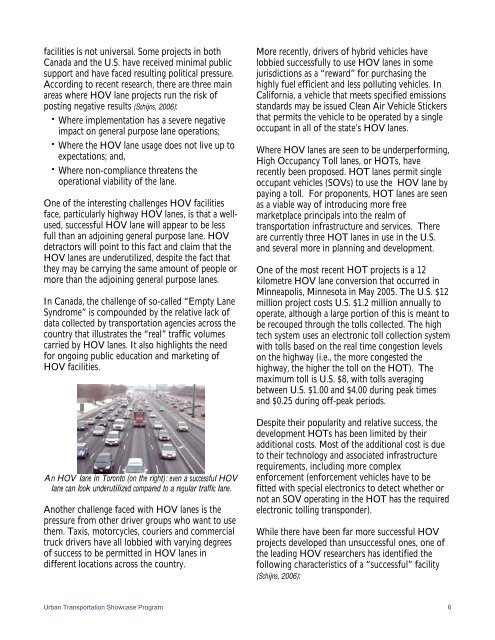High Occupancy Vehicle Lanes in Canada
High Occupancy Vehicle Lanes in Canada
High Occupancy Vehicle Lanes in Canada
You also want an ePaper? Increase the reach of your titles
YUMPU automatically turns print PDFs into web optimized ePapers that Google loves.
facilities is not universal. Some projects <strong>in</strong> both<br />
<strong>Canada</strong> and the U.S. have received m<strong>in</strong>imal public<br />
support and have faced result<strong>in</strong>g political pressure.<br />
Accord<strong>in</strong>g to recent research, there are three ma<strong>in</strong><br />
areas where HOV lane projects run the risk of<br />
post<strong>in</strong>g negative results (Schijns, 2006):<br />
• Where implementation has a severe negative<br />
impact on general purpose lane operations;<br />
• Where the HOV lane usage does not live up to<br />
expectations; and,<br />
• Where non-compliance threatens the<br />
operational viability of the lane.<br />
One of the <strong>in</strong>terest<strong>in</strong>g challenges HOV facilities<br />
face, particularly highway HOV lanes, is that a wellused,<br />
successful HOV lane will appear to be less<br />
full than an adjo<strong>in</strong><strong>in</strong>g general purpose lane. HOV<br />
detractors will po<strong>in</strong>t to this fact and claim that the<br />
HOV lanes are underutilized, despite the fact that<br />
they may be carry<strong>in</strong>g the same amount of people or<br />
more than the adjo<strong>in</strong><strong>in</strong>g general purpose lanes.<br />
In <strong>Canada</strong>, the challenge of so-called “Empty Lane<br />
Syndrome” is compounded by the relative lack of<br />
data collected by transportation agencies across the<br />
country that illustrates the “real” traffic volumes<br />
carried by HOV lanes. It also highlights the need<br />
for ongo<strong>in</strong>g public education and market<strong>in</strong>g of<br />
HOV facilities.<br />
An HOV lane <strong>in</strong> Toronto (on the right): even a successful HOV<br />
lane can look underutilized compared to a regular traffic lane.<br />
Another challenge faced with HOV lanes is the<br />
pressure from other driver groups who want to use<br />
them. Taxis, motorcycles, couriers and commercial<br />
truck drivers have all lobbied with vary<strong>in</strong>g degrees<br />
of success to be permitted <strong>in</strong> HOV lanes <strong>in</strong><br />
different locations across the country.<br />
More recently, drivers of hybrid vehicles have<br />
lobbied successfully to use HOV lanes <strong>in</strong> some<br />
jurisdictions as a “reward” for purchas<strong>in</strong>g the<br />
highly fuel efficient and less pollut<strong>in</strong>g vehicles. In<br />
California, a vehicle that meets specified emissions<br />
standards may be issued Clean Air <strong>Vehicle</strong> Stickers<br />
that permits the vehicle to be operated by a s<strong>in</strong>gle<br />
occupant <strong>in</strong> all of the state’s HOV lanes.<br />
Where HOV lanes are seen to be underperform<strong>in</strong>g,<br />
<strong>High</strong> <strong>Occupancy</strong> Toll lanes, or HOTs, have<br />
recently been proposed. HOT lanes permit s<strong>in</strong>gle<br />
occupant vehicles (SOVs) to use the HOV lane by<br />
pay<strong>in</strong>g a toll. For proponents, HOT lanes are seen<br />
as a viable way of <strong>in</strong>troduc<strong>in</strong>g more free<br />
marketplace pr<strong>in</strong>cipals <strong>in</strong>to the realm of<br />
transportation <strong>in</strong>frastructure and services. There<br />
are currently three HOT lanes <strong>in</strong> use <strong>in</strong> the U.S.<br />
and several more <strong>in</strong> plann<strong>in</strong>g and development.<br />
One of the most recent HOT projects is a 12<br />
kilometre HOV lane conversion that occurred <strong>in</strong><br />
M<strong>in</strong>neapolis, M<strong>in</strong>nesota <strong>in</strong> May 2005. The U.S. $12<br />
million project costs U.S. $1.2 million annually to<br />
operate, although a large portion of this is meant to<br />
be recouped through the tolls collected. The high<br />
tech system uses an electronic toll collection system<br />
with tolls based on the real time congestion levels<br />
on the highway (i.e., the more congested the<br />
highway, the higher the toll on the HOT). The<br />
maximum toll is U.S. $8, with tolls averag<strong>in</strong>g<br />
between U.S. $1.00 and $4.00 dur<strong>in</strong>g peak times<br />
and $0.25 dur<strong>in</strong>g off-peak periods.<br />
Despite their popularity and relative success, the<br />
development HOTs has been limited by their<br />
additional costs. Most of the additional cost is due<br />
to their technology and associated <strong>in</strong>frastructure<br />
requirements, <strong>in</strong>clud<strong>in</strong>g more complex<br />
enforcement (enforcement vehicles have to be<br />
fitted with special electronics to detect whether or<br />
not an SOV operat<strong>in</strong>g <strong>in</strong> the HOT has the required<br />
electronic toll<strong>in</strong>g transponder).<br />
While there have been far more successful HOV<br />
projects developed than unsuccessful ones, one of<br />
the lead<strong>in</strong>g HOV researchers has identified the<br />
follow<strong>in</strong>g characteristics of a “successful” facility<br />
(Schijns, 2006):<br />
Urban Transportation Showcase Program 6
















